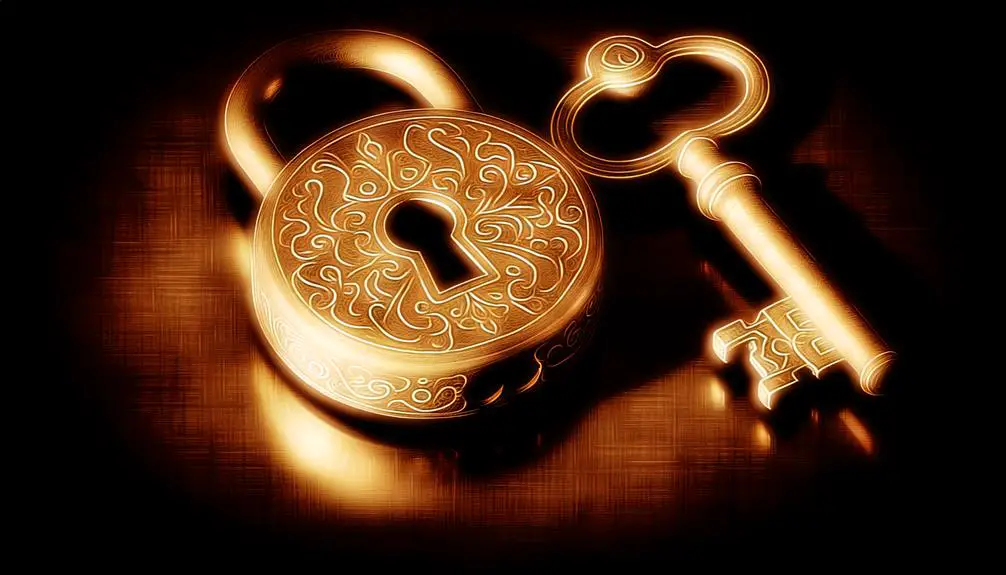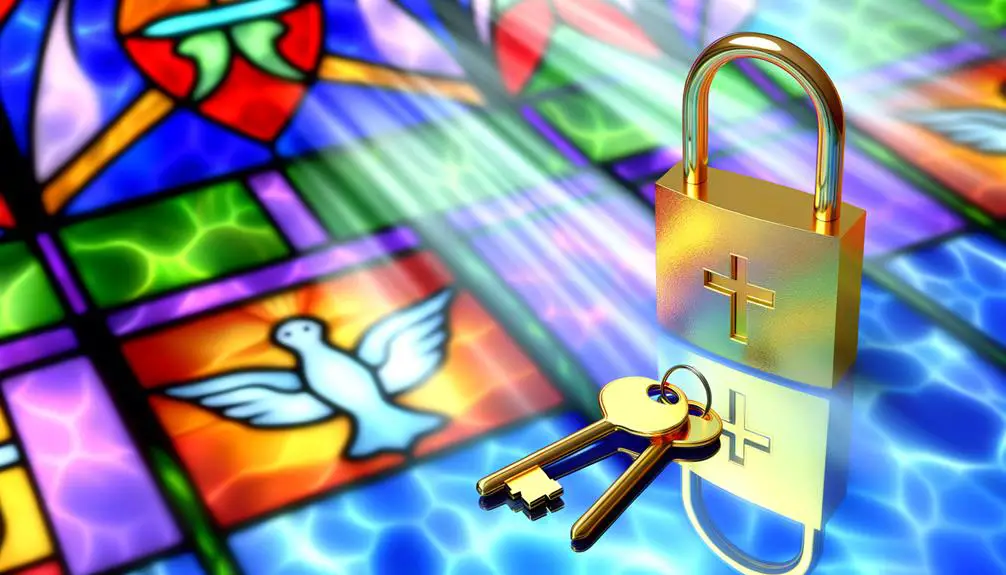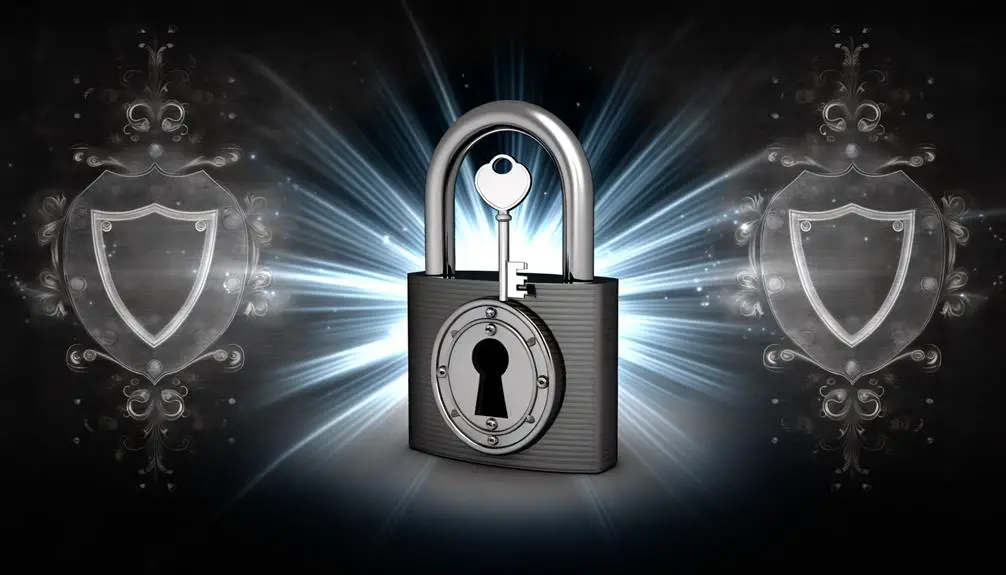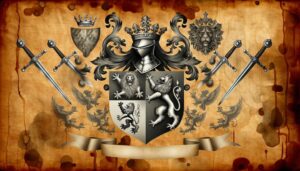What Is the Spiritual Meaning of the Lock and Key Symbol?
The fastener and key symbol has deep historical roots, tracing back to ancient civilizations such as Egypt and Rome, where it represented security and access privileges. In literature, it often signifies the opening of hidden truths and the quest for understanding.
Religiously, it symbolizes access to esoteric knowledge and spiritual enlightenment. Psychologically, fasteners represent barriers and keys symbolize the tools to overcome them, resonating with themes of vulnerability and trust.
Artistically, it has evolved to depict privacy, freedom, and societal constraints. The enduring metaphor of 'holding the key to one's heart' highlights its profound emotional significance.
To unearth more layers of this rich symbolism, explore further.

Key Takeaways
- The lock and key symbol represents security and protection, tracing back to ancient civilizations.
- In literature, it signifies revealing secrets, deeper truths, and transformative power.
- Religious traditions portray keys as access to esoteric knowledge and spiritual enlightenment.
- Historically, locks and keys symbolized wealth, status, and spiritual protection across various cultures.
- In modern contexts, they symbolize cybersecurity, encryption, and safeguarding information.
Historical Origins

The historical origins of the lock and key symbol can be traced back to ancient civilizations where they not only served practical purposes but also held significant symbolic meanings related to security, mystery, and knowledge.
In ancient Egypt, locks were crafted from wood, signifying the safeguarding of valuable possessions and sacred items. Similarly, in Roman society, the intricate metalwork of locks symbolized not just physical security but also the complexity of access and privilege, often associated with social status and power.
This dual function of practical utility and symbolic depth persisted through medieval times, where locks and keys adorned castle gates, representing protection and control. Over centuries, the lock and key evolved into potent emblems of both tangible and intangible forms of security.
Symbolism in Literature
In literature, the open and key metaphor often symbolizes the concealment and revelation of secrets, serving as a vital narrative device to explore hidden dimensions of characters and plot.
Historically, this imagery has been employed to represent the revealing of deeper truths or the unmasking of concealed motives, therefore adding layers of complexity to the narrative.
The thematic use of openings and keys resonates with the human quest for understanding and the transformative power of discovery.
Symbolic Hidden Secrets
Revealing the symbolic hidden secrets within literature, the access and key motif often signifies the discovery of concealed truths and the journey toward enlightenment. This symbolism finds its roots in historical contexts where physical accesses protected sacred or forbidden knowledge.
In literary works, the act of accessing often represents a pivotal moment of revelation or transformation, aligning with themes of self-discovery, hidden aspects of identity, and the unearthing of buried emotions. Authors employ this motif to build suspense, create layers of meaning, and engage readers in the protagonist's quest for understanding.
Through this symbolic lens, the access and key become metaphorical tools, guiding characters—and readers—toward deeper insights and profound revelations.
Unlocking Character Depths
When authors intricately weave the code and padlock motif into their narratives, they often use it as a powerful tool to reveal the depths of their characters' psyches, exposing hidden motivations and complex layers that propel the story forward.
Historically, this symbol has roots in ancient mythology, where codes represented authority and knowledge. In literature, it serves to decode inner worlds, providing insight into characters' struggles and desires.
This thematic device allows readers to explore concealed aspects of identity, morality, and personal growth. By deciphering these metaphorical doors, authors create multidimensional characters whose vulnerabilities and strengths are laid bare, engaging readers in a profound exploration of human nature and existential dilemmas.
Religious Connotations

Throughout various religious traditions, the key and gate symbol has often been employed to represent the esoteric knowledge and spiritual enlightenment that is accessible only to the initiated.
In Christian iconography, keys are synonymous with St. Peter, symbolizing the authority to access heavenly wisdom. Similarly, in Hinduism, gates and keys are metaphors for the opening of spiritual consciousness through meditation and devotion.
Ancient Egyptian mythology also revered these symbols, with the ankh, a key-like object, symbolizing life and divine protection. The thematic undercurrent across these traditions is the notion that divine truths and sacred knowledge require worthy seekers, individuals prepared to access deeper spiritual domains through faith, discipline, and moral integrity.
This pursuit reflects humanity's perennial quest for transcendence.
Romantic Interpretations
In the domain of romantic symbolism, the key and lock motif often encapsulates the themes of intimacy, trust, and the opening of one's heart to another. Historically, this imagery can be traced back to Victorian times, where lovers exchanged lockets and keys as tokens of their bond. This tradition endures in modern culture, representing the unique connection between two individuals.
The metaphor is rich with thematic implications:
- Commitment: Symbolizes the exclusivity of a romantic relationship.
- Secrecy: Represents the private, intimate aspects shared only between partners.
- Discovery: Embodies the journey of understanding and knowing one's partner deeply.
- Protection: Indicates the safeguarding of emotional and personal boundaries.
- Unity: Highlights the idea of two becoming one through mutual trust and affection.
This rich tapestry of meanings underscores its enduring presence in expressions of love.
Psychological Perspectives

From a psychological perspective, the lock and key symbol encapsulates notions of security and boundaries, serving as a metaphor for personal growth and self-discovery.
Historically, this imagery has been pivotal in understanding human behavior, providing a framework for examining how individuals establish trust and navigate vulnerability.
The thematic resonance of this symbol underscores the intricate balance between protecting oneself and the willingness to open up to transformative experiences.
Security and Boundaries
The lock and key symbol, steeped in historical significance, serves as a powerful metaphor for understanding the psychological constructs of security and personal boundaries. This emblem encapsulates the essence of safeguarding one's inner self from external intrusions and delineating the limits of personal space. The historical usage of locks and keys highlights themes of protection and selective access, which translates seamlessly into the field of psychology.
Boundary Setting: Establishing clear, non-negotiable limits.
Emotional Security: Creating a safe space for one's feelings.
Trust Management: Deciding who can access personal vulnerabilities.
Self-Preservation: Protecting oneself from potential harm.
Autonomy: Maintaining control over personal decisions and actions.
These elements underscore the importance of psychological security and the nuanced role boundaries play in mental well-being.
Personal Growth Metaphor
Building upon the foundational understanding of security and boundaries, the lock and key symbol further extends into the domain of personal growth, serving as a profound metaphor for revealing one's potential and journeying through the process of psychological development.
Historically, this metaphor has roots in alchemical traditions where the opening of hidden chambers represented the revelation of inner truths. Thematically, the key symbolizes knowledge, insight, or experiences necessary to open personal barriers. This process of opening is emblematic of overcoming psychological obstacles, facilitating self-discovery and transformation.
Ultimately, the lock represents the challenges and constraints that individuals must navigate, while the key signifies the tools and inner resources essential for growth, emphasizing the importance of introspection and perseverance in personal development.
Trust and Vulnerability
In psychological perspectives, trust and vulnerability are intricately linked concepts that play an essential role in the development of deep interpersonal relationships and the exploration of one's own psyche.
Historically, trust has been considered the 'key' that opens the 'door' of vulnerability, enabling individuals to form meaningful connections. Vulnerability, often perceived as a sign of weakness, is actually a profound strength that invites authenticity and intimacy.
- Historical context: Trust as a foundational element in human relationships.
- Thematic interpretation: Vulnerability as an essential component of emotional bonds.
- Psychological analysis: The interplay between trust and vulnerability in self-discovery.
- Interpersonal dynamics: How trust facilitates the sharing of vulnerabilities.
- Cultural perspectives: Variations in trust and vulnerability across societies.
Understanding these dynamics is essential for fostering genuine human connections.
Cultural Variations
Across different cultures, the symbolism of the lock and key has evolved to encompass a wide array of meanings, each deeply rooted in the historical and societal contexts of the respective communities.
In ancient Egypt, locks and keys represented wealth and status, often used to secure valuable possessions.
Meanwhile, in Chinese culture, locks are intricately tied to the concept of protection and longevity, frequently seen in talismans.
European traditions, especially during the medieval period, associated locks and keys with spiritual protection, often symbolizing the safeguarding of sacred knowledge.
In Japan, the lock and key metaphorically signify the preservation of secrets and the sanctity of private spaces, reflecting a broader cultural emphasis on privacy and discretion.
Modern Usage

Reflecting a continuation of historical and cultural richness, the modern usage of lock and key symbolism has expanded into contemporary contexts, encompassing areas such as cybersecurity, personal privacy, and emotional relationships. The symbol's inherent meanings of protection, secrecy, and intimacy are being adapted to address the complexities of modern life.
- Cybersecurity: Locks symbolize encryption, safeguarding digital information.
- Personal Privacy: Keys represent control over personal data and boundaries.
- Emotional Relationships: The metaphor of someone holding 'the key to one's heart' endures.
- Psychological Barriers: Locks signify internal hurdles and the keys to overcoming them.
- Legal and Financial Security: Keys are used symbolically in securing assets and identity verification.
This evolution underscores the enduring relevance and adaptability of lock and key symbolism.
Artistic Representations
Artistic representations of the lock and key motif span a broad historical spectrum, from Renaissance paintings symbolizing hidden knowledge to contemporary installations exploring themes of security and privacy.
In modern art, this symbolism has evolved, reflecting societal concerns about access and control in the digital age.
Additionally, cultural variations in artistic interpretation reveal diverse meanings, such as the use of locks and keys in Japanese art to signify spiritual protection.
Historical Artistic Depictions
Examining historical artistic depictions of locks and keys reveals their profound symbolic significance across various cultures and epochs. These artifacts have often been employed to convey themes of security, authority, and mystery within artistic contexts.
For instance, Renaissance paintings frequently utilized keys as symbols of divine authority or spiritual access. Similarly, Medieval art often depicted locks in association with chivalric tales, symbolizing purity and protection.
In East Asian traditions, locks and keys featured prominently in intricate metalwork, representing wealth and status.
- Renaissance Art: Keys symbolize spiritual and temporal authority.
- Medieval Manuscripts: Locks signify protection and purity.
- East Asian Metalwork: Indicators of wealth and status.
Ancient Egyptian relics also showcase keys linked to the afterlife and divine secrets, while Victorian jewelry incorporates locks as symbols of love and commitment.
- Ancient Egyptian Relics: Keys linked to the afterlife and divine secrets.
- Victorian Jewelry: Locks symbolize love and commitment.
These representations underscore the cultural and temporal breadth of their symbolic value.
Symbolism in Modern Art
In contemporary art, locks and keys continue serving as potent symbols, often evoking themes of privacy, identity, and the human psyche. Artists leverage these motifs to explore the dichotomy between concealment and revelation, as well as the tensions inherent in safeguarding one's inner world.
Historically, the concept of the lock has been associated with security and restriction, while the key symbolizes access and discovery. Modern interpretations extend this symbolism to nuanced explorations of personal freedom and societal constraints.
In works by contemporary artists such as Louise Bourgeois and Yayoi Kusama, the lock and key transcend their utilitarian origins to become evocative metaphors for existential inquiry, inviting viewers to contemplate the boundaries of their own psychological landscapes.
Cultural Artistic Variations
Building upon the rich symbolism of locks and keys in modern art, one can observe distinct cultural variations in their artistic representations, revealing diverse interpretations and significances across different societies.
In-depth analysis of these variations highlights how historical context and thematic elements shape their portrayal:
- Asian Art: Keys often symbolize spiritual enlightenment and the opening of inner wisdom.
- Middle Eastern Art: Locks and keys are frequently tied to themes of guardianship and sacred trust.
- African Art: Representations focus on community secrets and ancestral heritage.
- European Art: These symbols frequently allude to romance, mystery, and personal freedom.
- Latin American Art: Emphasis is placed on liberation from oppression and the pursuit of personal identity.
These thematic interpretations showcase the universal yet culturally specific nature of lock and key symbolism.
Security and Protection

The lock and key symbol has historically represented security and protection, serving as a powerful metaphor for safeguarding valuable assets and sensitive information. Originating from ancient civilizations, this emblem has transcended time to embody a profound sense of trust and reliability. The lock signifies barriers and defense mechanisms, while the key symbolizes the exclusive access granted to trusted individuals. This duality evokes a deep emotional resonance, as illustrated below:
| Symbol | Emotional Response | Historical Context |
|---|---|---|
| Lock | Safety | Ancient fortifications |
| Key | Trust | Medieval chivalry |
| Lock and Key | Assurance | Industrial Revolution |
This symbolism underscores the universal human desire for security, reinforcing its significance in both personal and societal contexts.
Mythological References
Throughout various mythological traditions, the seal and key symbol emerges as a potent emblem of hidden knowledge and divine protection, often associated with gods, guardians, and secret domains. This rich symbolism transcends cultures, offering profound insights into the human quest for understanding and security.
- Greek Mythology: Hecate, the goddess of magic and crossroads, is often depicted with keys, symbolizing her control over hidden knowledge and the underworld.
- Norse Mythology: The god Loki's name itself means 'seal', reflecting his role in both binding and sealing divine secrets.
- Egyptian Mythology: Anubis, the guardian of the dead, holds the key to the afterlife, safeguarding the secrets of resurrection.
- Christian Tradition: St. Peter is entrusted with the 'seals to the kingdom of heaven', symbolizing spiritual authority.
- Hindu Mythology: The god Vishnu carries a seal, representing preservation and the cosmic order.
Future Symbolism

In an increasingly digital world, the lock and key symbol is poised to evolve, representing the intersection of cybersecurity, privacy, and the safeguarding of personal and collective information.
Historically, locks and keys have symbolized physical security and the protection of tangible assets. As society shifts to virtual spaces, this emblem will increasingly denote encryption, data protection, and the defense against cyber threats.
Thematically, it underscores a perennial human concern: the need for security in an ever-changing environment. This evolution reflects broader societal shifts towards valuing digital integrity and confidentiality.
Consequently, future interpretations of the lock and key will integrate traditional notions of security with modern imperatives of digital trust and information sovereignty.
Conclusion
The lock and key symbol, steeped in historical context and thematic interpretation, transcends mere physical utility to embody profound philosophical and emotional dimensions.
From its ancient origins to modern artistic representations, this symbol encapsulates themes of security, mystery, and intimate connection.
Whether regarded through literary, religious, or psychological lenses, the lock and key persist as a powerful metaphor for the human experience, illustrating the intricate interplay between access and restriction, revelation and concealment.






